
Catalog excerpts

Thermal Analysis Excellence TGA-MS TGA-FTIR TGA-GC/MS TGA-Micro GC/MS STARe System Innovative Technology Versatile Modularity Swiss Quality Hyphenated Techniques Enable Compositional Analysis and Identification
Open the catalog to page 1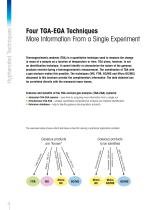
Hyphenated Techniques Four TGA-EGA Techniques More Information From a Single Experiment Thermogravimetric analysis (TGA) is a quantitative technique used to measure the change in mass of a sample as a function of temperature or time. TGA alone, however, is not an identification technique. It cannot identify or characterize the nature of the gaseous products evolved during a thermogravimetric measurement. The combination of TGA with a gas analyzer makes this possible. The techniques (MS, FTIR, GC/MS and Micro GC/MS) discussed in this brochure provide the complimentary information. The data...
Open the catalog to page 2
Evolved gas analysis – Applied Techniques TGA-MS TGA-Micro GC/MS Mass scan over a range of masses: Gram-Schmidt – total absorbance spectrum: TCD chromatogram (with gas detection): Analysis of selected ions: Functional groups profile (chemigrams): Identification of evolved compounds: Identification of evolved compounds: Gas profiling over the entire range of TGA experiment: Gas profiling over the entire range of TGA experiment: TGA-MS, TGA-FTIR, TGA-GC/MS and TGA-Micro GC/MS are powerful techniques that yield both quantitative (mass analysis, absorbance) and qualitative (identification, gas...
Open the catalog to page 3
TGA-Mass Spectrometry (MS) Fast and Highly Sensitive Mass spectrometry (MS) is an extremely sensitive analytical technique that is used to detect and identify trace amounts of gaseous substances. In a mass spectrometer, the molecules of a substance are first ionized. The molecular and fragment ions produced are then separated according to their mass-to-charge ratios (m/z). The technique can quantify atoms or molecules and provides chemical and structural information (functional groups and side chains) on the compounds analyzed. Features and benefits of a TGA-MS system: n Gas analysis by MS...
Open the catalog to page 4
Detection of residual solvents in an active pharmaceutical ingredient (API) In the production of APIs, traces of solvents often remain in the product. Combined techniques such as TGA-MS are ideal for detecting and identifying such undesired residues. In this example, methanol and acetone were used to recrystallize the active substance. The peaks on the MS curves corresponding to m/z 31 and m/z 43 confirm the presence of these two substances. The results indicate that the weight loss step at 200 °C is almost entirely due to the elimination of acetone. Definite analytical information like...
Open the catalog to page 5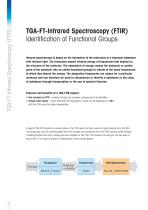
TGA-FT-Infrared Spectroscopy (FTIR) TGA-FT-Infrared Spectroscopy (FTIR) Identification of Functional Groups Infrared spectroscopy is based on the interaction of the molecules of a chemical substance with infrared light. The molecules absorb infrared energy at frequencies that depend on the structure of the molecule. The absorption of energy causes the molecule or certain parts of the molecule (the so-called functional groups) to vibrate at the same frequencies at which they absorb the energy. The absorption frequencies are unique for a particular molecule and can therefore be used to...
Open the catalog to page 6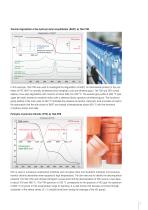
Thermal degradation of bis-hydroxyl-butyl-terephthalate (BHET) by TGA-FTIR In this example, TGA-FTIR was used to investigate the degradation of BHET, an intermediate product in the synthesis of PET. BHET is normally synthesized from terephalic acid and ethylene glycol. The TGA and DTG curves display a two-step degradation with maxima at about 300 and 440 °C. The evolved gas profile at 300 °C (see upper left inset) showed an excellent match with a reference library spectrum of ethylene glycol. The functional group profiles of the main peak at 440 °C indicated the presence of alcohol,...
Open the catalog to page 7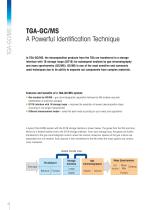
TGA-GC/MS A Powerful Identification Technique In TGA-GC/MS, the decomposition products from the TGA are transferred to a storage interface with 16 storage loops (IST16) for subsequent analysis by gas chromatography and mass spectrometry (GC/MS). GC/MS is one of the most sensitive and commonly used techniques due to its ability to separate out components from complex materials. Features and benefits of a TGA-GC/MS system: n Gas analysis by GC/MS – gas chromatographic separation followed by MS enables accurate identification of unknown samples n IST16 interface with 16 storage loops –...
Open the catalog to page 8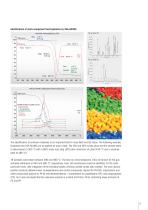
Identification of multi-component thermoplastics by TGA-GC/MS TIC at 440 ºC The identification of unknown materials is an important field in many R&D and QC areas. The following example illustrates how TGA-GC/MS can be applied for such a task. The TGA and DTG curves show that the sample starts to decompose at 300 °C with a 90% mass loss step (DTG peak maximum at about 440 °C and a shoulder peak at 480 °C). 16 samples were taken between 290 and 590 °C. The total ion chromatograms (TIC) are shown for the gas samples withdrawn at 440 and 480 °C, respectively. Over 130 substances could be...
Open the catalog to page 9
TGA-Micro GC/MS TGA-Micro GC/MS Real-Time Gas Identification/Quantification The mode of operation and the basic setup of a Micro GC and a classical GC are in principle the same. Even so, the components of a Micro GC (injector, separating column, detector) are distinctly smaller than in a classical GC. A Micro GC usually consists of several modules with different columns through which the gases being analyzed are injected in parallel. The time needed to record a chromatogram is significantly shorter (typically 2 to 3 minutes) due to the comparatively short columns used. Features and benefits...
Open the catalog to page 10
Quantification of CO2 in a coke sample by TGA-Micro GC Coke is the residue formed after heating bituminous coal to high temperatures in the absence of air, and is typically used in the iron production process. Coke which is one almost pure form of carbon, evolves almost pure CO2 on burning. The quality of the coke can be determined by the amount of released CO2. A coke sample was analyzed by TGA-Micro GC (PoraPLOT U column). The TGA curve showed that about 16.5% of the coke sample decomposed under the experimental conditions. All CO2 peaks obtained in the TCD chromatograms were integrated...
Open the catalog to page 11All SRA Instruments catalogs and technical brochures
-
1088 Rotary Autosampler
2 Pages
-
1030S TOC
2 Pages
-
Aurora 1030W
4 Pages
-
Aurora 1030C
4 Pages
-
1080
8 Pages
-
SRA MicroGC Portfolio
6 Pages
-
Thermal Analysis
40 Pages
-
NEW LAB SOLUTIONS
2 Pages
-
SRA R990
4 Pages
-
AG-OFGAS-35
2 Pages
-
NG 7040
2 Pages















